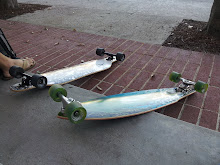I dropped by Union Station a couple weeks ago to do some fieldwork, doing some analysis of spaces of waiting. Union Station's an interesting spot. You can only sit and relax if you bought a ticket. You wait in comfort at an economic investment.
No plugs though. Or, rather, none that I could see in the sitting areas. And no one was plugged in. This indicates a couple possible of things to me. First of all it may be that the architecture of the place does not assume that people will need to use tech devices, and by assuming that, the place also indirectly assumes that the people who will be waiting there are not people who need to use tech devices - in other words, people who either cannot afford it, or whose time is not valuable enough to have to use technology to be productive. A stretch of the imagination? Maybe. Intentional? Maybe not. Perhaps this is the problem with interpretive analysis of spaces - we don't know for sure. But what I do know is, for the most part, trains in LA are not something people of a wide range of social classes take regularly. After all, a car gives one better control over one's time, and a plane is faster - both indicating higher temporal capital for those who choose (and can afford) to take these types of transportation. And while airports are scrambling to install more plugs, we shall see if the new renovations that Union Station is doing will take passengers' needs to be constantly connected into account.
No plugs though. Or, rather, none that I could see in the sitting areas. And no one was plugged in. This indicates a couple possible of things to me. First of all it may be that the architecture of the place does not assume that people will need to use tech devices, and by assuming that, the place also indirectly assumes that the people who will be waiting there are not people who need to use tech devices - in other words, people who either cannot afford it, or whose time is not valuable enough to have to use technology to be productive. A stretch of the imagination? Maybe. Intentional? Maybe not. Perhaps this is the problem with interpretive analysis of spaces - we don't know for sure. But what I do know is, for the most part, trains in LA are not something people of a wide range of social classes take regularly. After all, a car gives one better control over one's time, and a plane is faster - both indicating higher temporal capital for those who choose (and can afford) to take these types of transportation. And while airports are scrambling to install more plugs, we shall see if the new renovations that Union Station is doing will take passengers' needs to be constantly connected into account.



